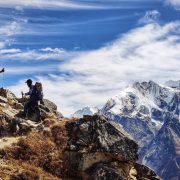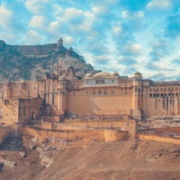Travelling is a part of our life, most of us love to travel. It is good for health also. Sometimes many doctors suggest their patients travel somewhere for a little refreshment and weather change. People should go out of their way to get out of boredom all year long.
Sikkim is a very beautiful state, which is situated in northeast India. It is bordered by Nepal (West), Bhutan (East), Tibet(North) and West Bengal(south). This second smallest hill state is full of biodiversity. Sikkim is a notable ecological hotspot, which includes subtropical and alpine climates as well as Kangchenjunga, the third-highest peak of the world and the highest peak of India. Various species of flowering plants, rare orchids, rhododendron, primula, bamboo, oak, tree ferns are found here. Sikkim is home to musk deer, snow leopard, red panda, Himalayan tahr, Himalayan serow, Himalayan marmot, common langur, Himalayan goral, muntjac, clouded leopard, Asian black bear, marbled cat, leopard cat, Himalayan jungle cat, hog badger, binturong, Tibetan wolf and dhole.
Now, here we’re going to provide some details about the best visiting places in Sikkim.
- TSOMGO LAKE:-
This lake is mainly known as change lake. It is located 38km away from Gangtok, the capital of Sikkim (on the way to Nathula or Nathu La). Tsomgo is situated at an altitude of 12,400 ft. Colourful prayer flags flutter around the lake. Chang lake can be reached from Gangtok. Take a cart from NJP to the capital city. Then one can buy a package for the lake, which is available every day. Tsomgo is a natural lake on top of the mountain which is oval, 1 km long and 15m deep. The lake freezes completely during winter. The main attraction here is natural beauty. From January to march the lake remains no cover. Anyone can enjoy the walkthrough, the frozen lake to explore the wonder of heaven in the surroundings and visit the temple of Lord Shiva.
- NATHULA PASS:-
It is situated at an altitude of 14,140 feet. It is one of the top tourist attractions in east Sikkim. This destination is not only geographical but also have historical and political significance. Nathula pass is only permissible for 5 days in a week except for Monday and Tuesday. It is 56 km away from Gangtok. Nathula is a high mountain pass of the Himalayas. It connects the Sikkim with China, Tibet. Only Citizens of India can visit the pass after getting a permit from Gangtok. Nathula Pass was the place that was used as the famous Silk Route till 1962. Both Indian and Chinese soldiers guard the border.
- TEESTA RIVER:-
The origin of the Teesta river is the Panhuri glacier (Teesta change) is located at an altitude of 23,189 feet and flows southward rapids in Sikkim Himalaya. Rivulets arising in Yumthang, Donkha and Thangu mountain ranges maintain the river flow. White sand covers both sides of the river. Large boulders in the water make it perfect for rafting interested tourists. In the monsoons, the river distends its banks both in size and turbulence. The total hydroelectric power potential of India is 84GW. Of this Sikkim shares 2.9% (4.29GW). Major completed dams and projects are
- Teesta V Dam is the largest project on Teesta in the Dikchu district in East Sikkim. It has 510 MW hydroelectric power generating capacity and helps in flood control.
- Ranjeet all hydroelectric project over the river Ranjeet, a tributary of Teesta river. It produces 60MW hydroelectric power.
- Singalila National park:-
It is a national park of India is located on the Sikkim-West Bengal border, mainly in Darjeeling which is at an altitude of 7000 feet from sea level. At first, it was a wildlife sanctuary in 1986 than in 1992, it is converted into an Indian National Park. This park is used as the trekking route to Sandakphu. There are three types of biome in the park, they are –
- Temperate coniferous forests biome
- Temperate broadleaf and mixed forests biome
- Subtropical coniferous forests biome
The flora of Singalila National Park includes bamboo, oak, rhododendron, magnolia, Geranium, Saxifraga, Primula, Bistort and numerous kids. Barking deer, red panda, leopard cat, yellow-throated marten, Himalayan black bear, takin, wild bopangolin, kali pheasant, scarlet minivet, satyr tragopan, golden reposted fulvetta, fire tailed my or is and various species of migratory birds are found here.
- PHODONG MONASTERY:-
This Buddhist monastery is located 28km away from Gangtok, in Sikkim. It was established in the early 18th century. A special festival called “Cham Dance” takes place in this monastery on the 28th and 29th of the 10th month. The king of Sikkim invited 9th Karmapa, who founded Phodong Monastery. Sidkeong Tulku Namgyal reconstructed this. The monastery is a residence of almost 260 monks as well as a valuable collection of ancient murals.
- GOECHALA:-
Goechala or Goecha La is another high mountain pass of the Himalayan range in Sikkim. It is situated at an altitude of 16,207 feet. From Goechala pass we can see the breathtaking amazing view of Kanchenjunga Mountain. When the Indian government first saw this view they decided to put it on Rs.100 note as a feature. On the Goechala trek from Thansing and Dzongri top, other Himalayan peaks are also seen. They are Talung, Rathong, Koktang and Simco.
- KANCHENJUNGA NATIONAL PARK:-
It is a biosphere reserve located in Sikkim. It was included in the UNESCO World Heritage Site List on July 17, 2016; and became the first ‘Mixed Heritage’ site of India. The name is given to the park from the mountain Kanchenjunga(8,586 meters tall). The Kanchenjunga National park includes the Zemu glacier. Animals like clouded leopard, musk deer, wild dog, sloth bear, red panda, Tibetan wild ass, Himalayan blue sheep, snow leopard, Himalayan tahr, rat snake, Russell’s viper and other exotic wildlife species(550 species of birds) all make their home in this park. This park is situated in the North and West Sikkim districts in the Indian state of Sikkim. It has an elevation of 1,829 meters to over 8,550 meters and has an area of 84,950 square kilometers. In the west, it adjoins the Kanchenjunga Conservation Area in Nepal and the north Qomolangma preserve in Tibet. This park includes temperate broadleaf and mixed forests consisting of oaks, fir, birch, maple, willow, alpine grasses and shrubs and higher altitude contain many contain plants and herbs etc. The best season to visit the park is from April to May. Snowfall is heavy during the winter months and monsoon showers occur between may to mid-October.
- DO DRUL CHORTEN:-
It is a stupa in Gangtok, Sikkim. In 1945 the head of Nyingma, Trulshik Rinpoche built this stupa in order of Tibetan Buddhism. There is a set of Dorjee phurba, Kangyur(holy books) and other ancient religious objects in the stupa. The stupa is surrounded by 108 Mani Lhakor(prayer wheels). Around the stupa, two statues of Guru Rinpoche are found- Chorten Lakahang and Gurung Lakhang.
- KANCHENJUNGA BASE CAMP:-
In the Tibetan language, the name ‘Kanchenjunga’ indicates ‘five great treasures of snow’. Perfect seasons for basecamp are March, April, May, September, October, November. For trekking to base camp starting and ending point is Taplejung/Suketar. During this camping, a trekker can visit Pathibara temple, an important religious holy place for Nepali and Indian pilgrims. The trail goes to Ghumsa(northward) then it turns to the Kanchenjunga base camp going through an attractive high Alpine view. After that, it goes to the Yalung camp via 2 passes. Then it goes back to the starting point Taplejung. Trekkers go via the Kanchenjunga Conservation Area, one of the least populated areas. It is managed by local communities with the help of WWF. This area is home to the endangered red panda and snow leopard, the Assamese macaque, clouded leopard and Himalayan black bear.
SINGALILA:-
It is a north-south mountain ridge starting from West Bengal to the Sikkim(the Indian part of the Himalayas). In the ridge two highest peaks of West Bengal is located in Sandakphu and Phalut. Other famous peaks are Tonglu and Sabargram. The Singalila National Park surrounds the ridge, which we have discussed before already. It is known for views of Mount Everest and Kanchenjunga. For mountain biking and trekking to Sandakphu, Singalila ridge is the most adventurous route.
ZERO POINT:-
Sikkim visit is incomplete if we don’t visit zero point and Yumthang. The journey starts from an overnight stay in Lachung(8610 feet) 110 km from Gangtok. On the way to Lachung, we come across Bhimnala or Bhewma Falls. Yumthang Valley is 1.5 hrs. drive from Lachung. This valley is home to Shingba Rhododendron Sanctuary. There are a couple of rivers- Yumthang chu and Puniya chu where tourists can go fishing. Before entering the valley there is a pathway leading to Yumthang Hot Spring. The water is rich in sulphur and has medicinal properties. Once again we can see the unison of snow, cloud, Valley hills dancing on the curves of nature. It is situated at an altitude of 15000 feet above sea level. It is called zero-point because the civilian road ends here. It is very near to the China border, so special permission is needed to visit here. This is the place where three rivers meet in the lap of snow-clad mountains. It is known that The Zero Point is a little piece of Heaven on Earth because of its never-ending beautiful white scenario. In this beautiful place, tourists also play with snowfalls.
ENCHEY MONASTERY:-
It holds ancient relics, scriptures, and artefacts of immense historical, educational, artistic and religious importance. The intricate artwork, statues and thangkas make Enchey a beautiful place to see. Enchey Gumpha means a solitary monastery. It was first built by the 8th Chogyal (king) of Sikkim in 1840 AD and given its present state in 1905. This Gumpha comes under the Nyingmapa sect of Buddhism. The monastery was severely damaged in the earthquake of 2006. According to a legend, Guru Padmasambhava himself had subdued the spirits of the Kanchenjunga, Yabden and Mahakal here. Their mighty spirits are believed to be residing at Enchey.
NAMGYAL INSTITUTE OF TIBETOLOGY:-
It is a Tibet museum in Gangtok, Sikkim. 11th King of Sikkim, Sir Tashi Namgyal established this. It has sponsored research on the history, religion, culture, art and language of the Tibetan cultural people of Sikkim. The library of this institute contains the largest collections of Tibetan works over religious art and iconography. Since 1964 NIT has published bulletins on Tibetology.
SIKKIM HIMALAYAN ZOOLOGICAL PARK:-
It is an attractive place for wildlife lovers in the Sikkim. This park is established to protect the exotic, vulnerable, endangered and normal animals without disturbing any creatures and keeping them in their natural habitat. It is situated at an altitude of 1780 meters and 3 km away from Gangtok. This zoological park covers 205 hectares area of mountainous area. It includes varieties of fauna species like red panda, Himalayan black bear, Himalayan monal pheasant, crimson horned pheasant, etc. The best season to visit The Himalayan Zoological Park is mid-February to May and mid-September to December.
HANUMAN TOK:-
It is situated 9km away from Gangtok. We have to go through a zig-zag road in the mountains. Hanuman Tok is a temple and a viewpoint maintained by the black cat division of Indian army. The temple is dedicated to Lord Rama, Lakshmana, Seeta and Hanuman. Before entering we can see a wall statue of Hanuman. The main temple is located at a height, so we have to cover several steps for going inside. There are many hanging bells throughout the way. There is a watchtower beside the temple to take spectacular views of the Himalayan mountains. We could see the whole beautiful town of Gangtok.
-

1 8 Useful International Travel Tips for First-Time Travelers
-

2 Little Denmark In A Quaint Little Place A Few Hours From Pondicherry
-

3 A Foodie’s Guide: Culinary Delights from Calgary to Saskatoon
-

4 15 Best Budget-friendly Himalayan Treks
-

5 Best Yet Cheap Hotels in Santo Domingo, Caribbean For Families
-

6 10 Best Places in Jaipur to Visit
-

7 A Solo Tripper’s Guide to Igatpuri
-

8 10 Best Tourist Spots In Armenia
-

9 These are the Must-See Places in Doha, Qatar
-

10 Best Things To Do In Udine

